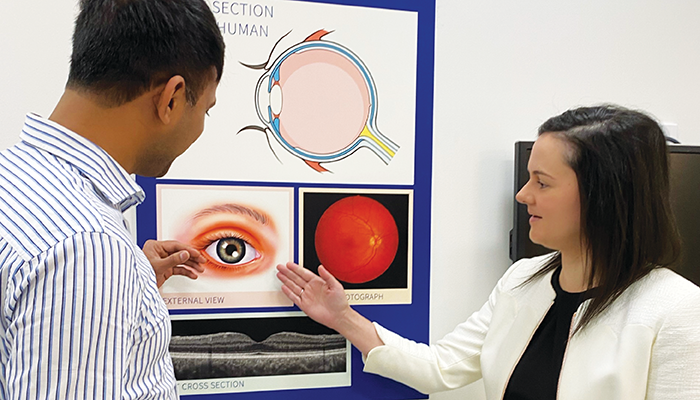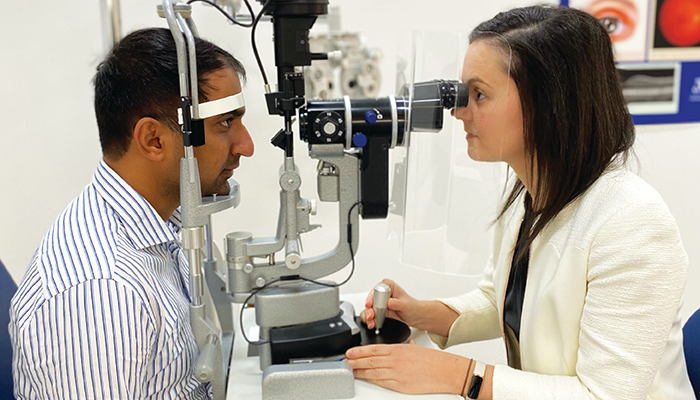
Laura Downie and Sumeer Singh (Credit: Ji-hyun (Anna) Lee)
Like several other chronic, age-related conditions, dry eye disease (DED) – which affects up to one in five people over 50 – can worsen with hot weather, hormone changes, and certain medications. But generally it has two root causes: either your eyes don’t produce enough tears or your tears evaporate too quickly. For many eye care professionals, it’s a fateful reality that – while both subtypes can be effectively treated – millions of people continue to live in pain simply because they’re not properly diagnosed.
“Dry eye disease is incredibly prevalent,” says Melissa Barnett, Director of Optometry at the University of California. “This condition is having a huge impact on people’s wellbeing, and economic productivity more broadly. However, the simple fact is that effective treatment is being hindered by widespread underdiagnosis.”
Cross-town collaboration
Enter a small device with a big name: acoustically-driven microfluidic extensional rheometry (ADMiER). The result of a cross-university collaboration led by Laura Downie, Director of the University of Melbourne’s Anterior Eye, Clinical Trials and Research Translation Unit, ADMiER has undergone thousands of hours of rigorous lab development and testing – backed by a team of specialized medical engineers working under Leslie Yeo at the neighboring RMIT University. In 2022, the co-inventors secured three patents for ADMiER, with the ambition to commercialize the device and deliver the technology to eye care clinicians across the globe.
Unlike other methods for evaluating dry eye disease, which involve dyes or filter papers, ADMiER can achieve a comprehensive diagnosis from a microliter teardrop. And it does so in just three minutes – a drastic reduction on the 18–20 minutes required for current best-practice tests.
For Barnett, this combination of ease, speed, and diagnostic accuracy adds up to a compelling clinical equation. “The key to treating dry eye is having as much clinical information as possible,” she says. “The fact that a staff member, with a bit of training, can produce a full diagnostic analysis of the tear film means that you will not only determine the specific subtype the patient has, but also gather a wealth of clinical data to inform their treatment plan.”
Stretching is the truth
ADMiER uses a surface acoustic wave – sometimes described as a “mini earthquake” – to evaluate the physical conduct of a tear droplet. Over a matter of milliseconds, the tear’s fluid behaviors are analyzed, producing a set of measurements related to its extensional viscosity – or “stretchiness.”
“Our team discovered that tears from people with DED have altered stretchiness behaviors, which was the first time this has ever been shown,” explains Downie. “Using this approach, we are able to identify when tears are healthy or dry, and how they perform on the surface of the eye.”
Up to now, the only way of comprehensively diagnosing DED has involved a complex series of tests which assess various aspects of tear health, including the health of your tear glands, the salt concentration in your tears, and their rates of production and evaporation. The complexity of these tests – and the expertise required to administer them – has rendered DED a subjective and often inaccurate science.
Studies in Australia suggest the lack of uniformity in testing and grading invariably result in inconsistent clinical care (1). “Our research suggests that as many as 80 percent of patients never get an accurate diagnosis,” adds Downie.
The costs of accuracy
Downie’s team estimates that ADMiER will be highly economical to integrate into eye care clinics, reducing the financial burden of DED diagnosis.
“This device will be of huge value to any optometry or ophthalmology clinic, as well as not-for-profits involved in eye care, like the Lions or Rotary Clubs,” says Sumeer Singh, a researcher in Downie’s team. “If you add up all the tests required for an accurate dry eye diagnosis, ADMiER will obviously be better value as a single solution – let alone what it will save through better-informed treatments and patient monitoring.”
To date, ADMiER has been tested in two prospective clinical studies, with the collected data showing the device delivering high accuracy. “All the volunteers in the studies said the same thing,” says Singh. “That dry eyes really affected their lives, and they would love to see a way of simply diagnosing dry eyes to help them quickly and easily get the right treatment.”
Downie’s research has been supported by a number of major research grants, including the American Academy of Optometry’s Korb-Exford Dry Eye Career Development Award, and a five-year Development grant from Australia’s National Health and Medical Research Council. Though continuing to explore different paths to commercialization and investment, Downie says her top priority is to see the technology reach the people who most need it.
“I believe ADMiER has the capacity to become the global standard for clinical tear assessment,” she says. “But ultimately, the reason my team has been doing this work for nearly a decade remains the same: to help people suffering from dry eye disease get an accurate clinical diagnosis, which will inform a treatment plan that helps them to live more productive and pain-free lives.”

Laura Downie and Sumeer Singh (Credit: Ji-hyun (Anna) Lee)
References
- LE Downie et al., “An evidence-based analysis of Australian optometrists’ dry eye practices,” Optom Vis Sci, 12, 1385 (2013). PMID: 24212185.
